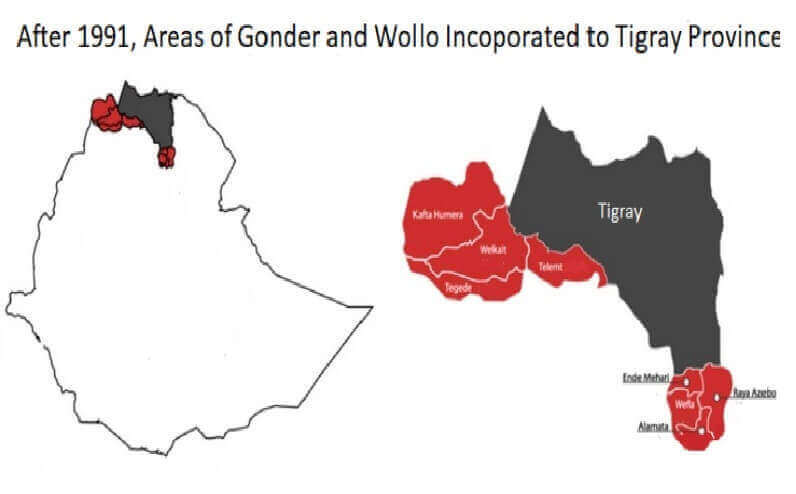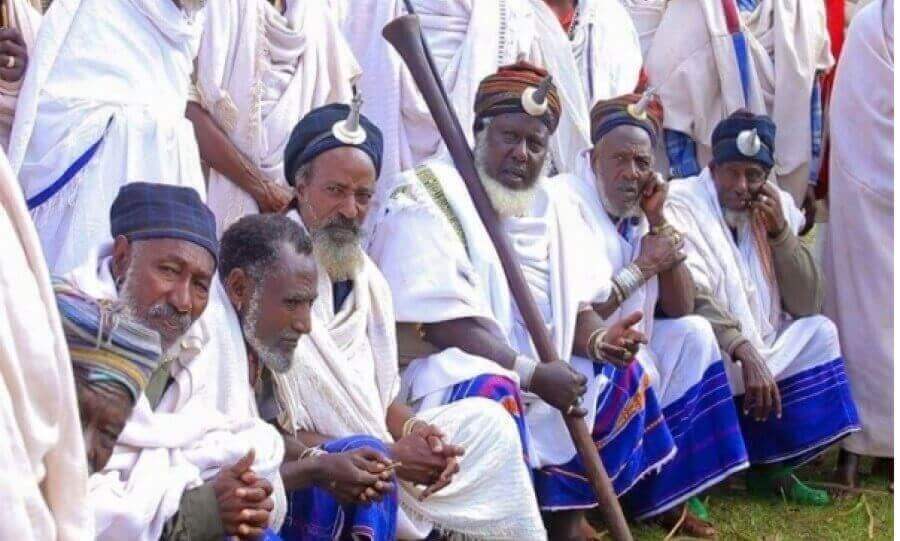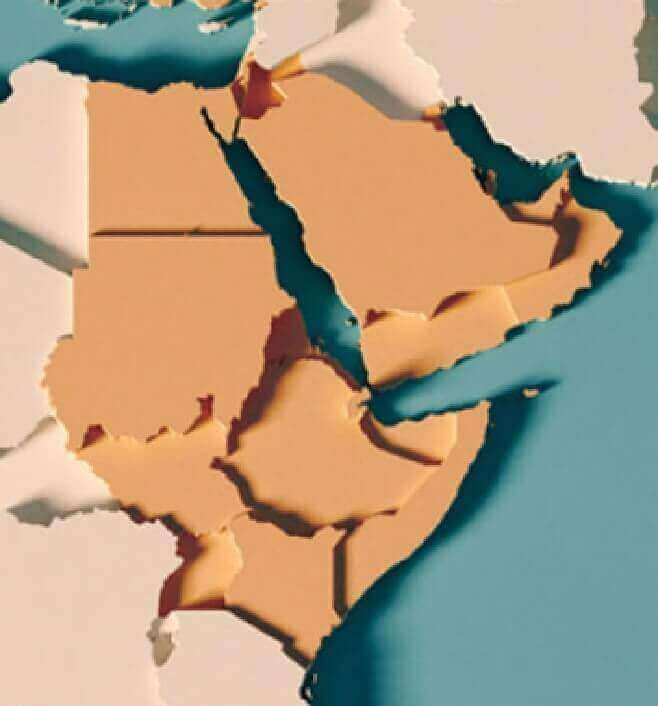By Concerned Ethiopians
 Over the past six decades, ethnocentric Ethiopian politicians have tried to paint the Amhara people as a privileged group that must be weakened. The aim of weakening the Orthodox Christian religion, the Amhara people, and Ethiopia was concocted during Italian occupation in the late 1930s. The main reason the Italians intended to govern Ethiopia along ethnic lines was to implement a divide-and-rule strategy. Similarly, starting with the Walelgne paper, the goal of reconfiguring the Ethiopian state involved blaming the Amhara people for the oppression of other ethnic groups so they would not play any significant role in the country’s politics. Muluken Tesfaw Admassu’s book “The Amhara Holocaust: Accounts of the Hidden Genocide of the Amhara People in Ethiopia” (1) details the systemic victimization of the Amhara people. The TPLF (Tigray People’s Liberation Front) and its successor Prosperity Party have used weak Amhara Region leaders to make Amhara people grudgingly acquiesce yet still resent this kind of treatment.
Over the past six decades, ethnocentric Ethiopian politicians have tried to paint the Amhara people as a privileged group that must be weakened. The aim of weakening the Orthodox Christian religion, the Amhara people, and Ethiopia was concocted during Italian occupation in the late 1930s. The main reason the Italians intended to govern Ethiopia along ethnic lines was to implement a divide-and-rule strategy. Similarly, starting with the Walelgne paper, the goal of reconfiguring the Ethiopian state involved blaming the Amhara people for the oppression of other ethnic groups so they would not play any significant role in the country’s politics. Muluken Tesfaw Admassu’s book “The Amhara Holocaust: Accounts of the Hidden Genocide of the Amhara People in Ethiopia” (1) details the systemic victimization of the Amhara people. The TPLF (Tigray People’s Liberation Front) and its successor Prosperity Party have used weak Amhara Region leaders to make Amhara people grudgingly acquiesce yet still resent this kind of treatment.
The mass murder, persecution, and displacement of the Amhara people in Benishangul Gumuz, Oromia, and Addis Ababa Regions during the last five years have made the Amhara people rebel against PM Abiy’s regime. The final straw for the Amhara people’s current uprising is PM Abiy’s decision to forcefully and unilaterally disarm Amhara Militias while leaving TPLF’s weapons intact. It is fair to assume that Tigray and Federal military forces can invade Welkait anytime. However, Eritrea is expected to counter this possible military action. In addition, considering how PM Abiys’s offensive in the Amhara region is a total failure, the likelihood of any attack on Welkait is low.
The north Ethiopia war of 2020 to 2022 has left many Amharas dead on their own land and the destruction of property. The Amhara people have been victims of decade-long suppression. The Welkait, Telemt, Tegede, and Raya Identity and Border Issues are the microcosm of the Amhara peoples demands for restitution and their rights. It is the Welkait Issue that especially encapsulates the Amhara Question.
Many researchers have documented how the Wolkait area was forcefully annexed into the Tigray Region in the early 1990’s. The Wolkait Affairs (2) book by Achamyeleh Tamiru provides authoritative historical, political, and demographic explanations on why the Welkait region belongs to the Amhara people. Other authors such as Abel Tesfaye, (3) Sonja John (4) (5) also detail arguments on why Welkait belongs to the Amhara people. For many Ethiopians, Welkait belongs to the Amharas, and with the Tekeze River being a natural barrier, the so-called “Western Tigray” is east of the Tekeze River or the Shire area.
In a February 2016 VOA interview (6), Leul Ras Mengesha Seyoum, who was the Governor of Tigray Province from 1961-1974, stated historical facts about the Welkait/Tsegede and the Tigray Regional State that agree with the above researchers. In July 2021, Ambassador Taye Atske Selassie explained in the security council (7) the significance of Welkait’s affiliation with Amhara.
Thirty years after Welkait was annexed, the issue remains as an Amhara Identity and Rights Question. The petition sent to the late PM Meles in November 1991 has never been answered. Those such as Col. Demeke Mekonnen, who raised the issue in 2016, were instead arrested. It is worth noting that the TPLF would not have been deposed in 2018 had the Amhara uprising not been ignited by the defiance of Col. Demeke (8) against those trying to arrest him for raising the Welkait Issue.
The Amhara Prosperity Party (APP) seems to waver between accepting the pre–November Welkait border or demanding for the Amhara people “ርስት ሳይሆን መብት – not just historical lands but rights” (9), (10), (11) & (12). However, kowtowing to its parent Prosperity Party, APP is complicit in identifying Fano (Amhara Militias) as a threat to PM Abiy’s hold on power. PM Abiy has betrayed Amharas and stabbed Fano in the back after fighting TPLF together with Fano. He made the disastrous decision to invade the Amhara region to unilaterally disarm Fano in May 2023 while leaving TPLF with light and heavy weapons intact. To make matters worse, no effort was made to disarm the Oromo Liberation Army.
It is evident that PM Abiy has chosen not to enforce the Pretoria agreement, where TPLF was supposed to disarm. Instead, he has made the political miscalculation that a weaker Amhara people will pose no threat to his power and has chosen to implement the “Nairobi/Halaba” secret deals between himself and TPLF. Some suggest PM Abiy is bowing to the US pressure to give back Welkait to Tigray as he needs loan restructuring and grants from the West. However, engaging in an unjust war that a war-devastated economy cannot afford has led to runaway inflation. Many expect further skyrocketing food prices, such as teff from Gojjam, due to the war on Amharas. There is no doubt that urban dwellers would rise up against the PM Abiy Regime, if they cannot feed themselves. The astute political decision would have been to take a principled stand on people’s rights. The United States cannot effectively deal with a leader despised by the people he governs and who frequently shifts alliances so much that he is unworthy of their trust. Additionally, the US always aligns itself with the faction deemed most likely to achieve victory, as exemplified by their suggestion to Prime Minister Abiy in November 2021 when TPLF was 120 km from Addis Ababa.
Several public statements online where PM Abiy confirmed Amhara’s grievances about Welkait are well documented (13). Yet, Ethiopia’s Defense Minister, Abraham Belay, on his official Facebook account (14), stated that the government plans to use the “army” to integrate Welkait into the Tigray region. It is for this reason that the Amhara people and Fano would not give up their arms. Some suggest a referendum. However, the demographic engineering that Ex-TPLF Public Relations Officer Mekonen Zelelew well documents in Achamyeleh’s book (2), pages 427 to 470, makes it difficult to determine who will vote on the referendum. Besides, under PM Abiy, the independence of the institution that would hold a referendum – the National Electoral Board of Ethiopia is seriously in doubt with W/O Birtukan Midekssa’s resignation as the chair. Supporters of PM Abiy argue that he is an elected leader. That avenue is practically non-existent since there is no feasible mechanism to remove him from office via a recall election on a politician who has lost the public’s trust.
The Amhara people have therefore found it imperative to strengthen their resistance and force PM Abiy to abandon his invasion of the Amhara Region. Once it is successful in the Amhara Region, the next step is to forge alliances with those opposed to PM Abiy and capture Addis Ababa. The Amhara Popular Front’s motto “መነሻችን አማራ መዳረሻችን ኢትዮጲያ – begin with Amhara, reach all Ethiopia” is a powerful message that resonates with other ethnic groups in Ethiopia. The overreach of the Oromo Prosperity Party has alienated many Ethiopian Ethnic Groups especially those bordering the Oromo Region. Oromia region leaders saying that they have broken the backs of others will be met with equal resistance as no Ethiopian will tolerate such a slur. Reimagining Ethiopia cannot be done at the expense of others.
Prosperity Party is currently more despised than the TPLF. Ethiopians view PM Abiy as a political peddler out for his own benefit only. The only prosperity that Ethiopians have seen is for ethnically and politically connected people who have enriched themselves. PM Abiy’s shifting alliances have made him completely lose any modicum of credibility he ever had with any ethnic group in Ethiopia, whether it is the Southern people, Tigrayans, or Oromos, let alone Amharas. Ethiopians will not be deceived by opportunist politicians waxing the virtues of “coming together – መደመር” anymore.
The Amhara Issue necessitates a profound display of steadfast resistance and leadership. The diverse Ethiopian Fano forces, Amhara resistance leaders, and their many diaspora supporters must work together to highlight the Amhara cause to the global community.
For the last 30 years, politicians have tried to sow discord and label Amharas as the oppressors, while the truth was and still exists that the Amharas have been discriminated against. The Welkait issue is a stark harbinger of the question of rights raised by the Amhara people. It encompasses the role Amhara people need to get in Ethiopia. The fundamental right of Amharas to live in peace and security in any part of the country must be guaranteed as it is their fundamental right. Put simply, the Amhara people’s rights must be respected. Amharas should get a fair share of the country’s resources, let alone in disputed Amhara lands. Not enough work has been done to amend the constitution so that ethnocentric politics can no longer be used to target any ethnic group. Therefore, the Amhara fight for their right is pivotal in changing Ethiopia’s dangerous course, which could lead to its disintegration.
References:
- https://www.amazon.com/Amhara-Holocaust-Accounts-Genocide-Ethiopia-ebook/dp/B09YCBX9W3
- https://www.amazon.com/-/he/Achamyeleh-Tamiru/dp/1513653806
- https://www.ethiopia-insight.com/2022/08/03/under-ethiopias-federal-system-western-tigray-belongs-in-tigray/
- https://journals.sagepub.com/doi/10.1177/00219096211007657
- https://blogs.lse.ac.uk/africaatlse/2021/09/13/civil-rights-activists-welkait-tplf-peace-democracy-ethiopia-pp-abiy-ahmed/
- https://m.youtube.com/watch?v=Oi4MQOie4PA45
- https://www.youtube.com/watch?v=mgc2vZ4ie4M
- https://www.africanews.com/2016/07/31/half-a-million-protesters-call-for-a-regime-change-in-ethiopia/
- https://t.me/amharaapp/303
- https://www.tiktok.com/@amharaprosperitypartyapp/video/7258306388064079105
- https://twitter.com/appamhara/status/1632343851800174593?s=43&t=JNEY7rZ3zMv10cr2WDG2Qw
- https://www.tiktok.com/@amharaprosperitypartyapp/video/7207021740659084545
- https://twitter.com/TrueSeal3/status/169579687675321549
- https://www.facebook.com/AbrahamBelayOfficial

















